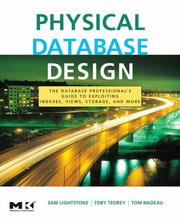| Listing 1 - 2 of 2 |
Sort by
|

ISBN: 9780123693891 0123693896 9786611046545 128104654X 0080552315 9780080552316 6611046542 Year: 2007 Publisher: Amsterdam ; Boston : Morgan Kaufmann/Elsevier,
Abstract | Keywords | Export | Availability | Bookmark
 Loading...
Loading...Choose an application
- Reference Manager
- EndNote
- RefWorks (Direct export to RefWorks)
The rapidly increasing volume of information contained in relational databases places a strain on databases, performance, and maintainability: DBAs are under greater pressure than ever to optimize database structure for system performance and administration. Physical Database Design discusses the concept of how physical structures of databases affect performance, including specific examples, guidelines, and best and worst practices for a variety of DBMSs and configurations. Something as simple as improving the table index design has a profound impact on performance. Every form
Database design --- Bases de données --- Conception --- Database design. --- Data base design --- System design --- Bases de données --- Information Technology --- General and Others --- Informatica --- Systeemontwikkeling

ISBN: 9780123693891 0123693896 9780080552316 0080552315 9786611046545 6611046542 Year: 2007 Publisher: Boston Morgan Kaufmann/Elsevier
Abstract | Keywords | Export | Availability | Bookmark
 Loading...
Loading...Choose an application
- Reference Manager
- EndNote
- RefWorks (Direct export to RefWorks)
I highly recommend Physical Database Design by Lightstone, Teorey, and Nadeau. The book covers fine aspects of physical design -- issues such as the effects of different approaches to indexes, tradeoffs in materializing views, and details of physical data layout. Unlike other books, it does not focus on a particular product, but instead covers the deep principles that cut across products. The book addresses both transaction intensive applications (OLTP) as well as data warehouses (OLAP). Their new book is a welcome addition to the literature. --Michael Blaha, OMT Associates, Inc. This is an excellent book on physical database design, giving pragmatic models and advice. It has a wealth of information for both the student and for the practitioner -- presenting analytic models and practical tips that are demonstrated with examples using Oracle, DB2, and Microsoft SQL Server. --Jim Gray, Microsoft Research The rapidly increasing volume of information contained in relational databases places a strain on databases, performance, and maintainability: DBAs are under greater pressure than ever to optimize database structure for system performance and administration. Physical Database Design discusses the concept of how physical structures of databases affect performance, including specific examples, guidelines, and best and worst practices for a variety of DBMSs and configurations. Something as simple as improving the table index design has a profound impact on performance. Every form of relational database, such as Online Transaction Processing (OLTP), Enterprise Resource Management (ERP), Data Mining (DM), or Management Resource Planning (MRP), can be improved using the methods provided in the book. Features The first complete treatment on physical database design, written by the authors of the seminal, Database Modeling and Design: Logical Design, 4th edition. Includes an introduction to the major concepts of physical database design as well as detailed examples, using methodologies and tools most popular for relational databases today: Oracle, DB2 (IBM), and SQL Server (Microsoft). Focuses on physical database design for exploiting B+tree indexing, clustered indexes, multidimensional clustering (MDC), range partitioning, shared nothing partitioning, shared disk data placement, materialized views, bitmap indexes, automated design tools, and more! The first complete treatment on physical database design, written by the authors of the seminal, Database Modeling and Design: Logical Design, 4th edition. Includes an introduction to the major concepts of physical database design as well as detailed examples, using methodologies and tools most popular for relational databases today: Oracle, DB2 (IBM), and SQL Server (Microsoft). Focuses on physical database design for exploiting B+tree indexing, clustered indexes, multidimensional clustering (MDC), range partitioning, shared nothing partitioning, shared disk data placement, materialized views, bitmap indexes, automated design tools, and more!
| Listing 1 - 2 of 2 |
Sort by
|

 Search
Search Feedback
Feedback About
About Help
Help News
News